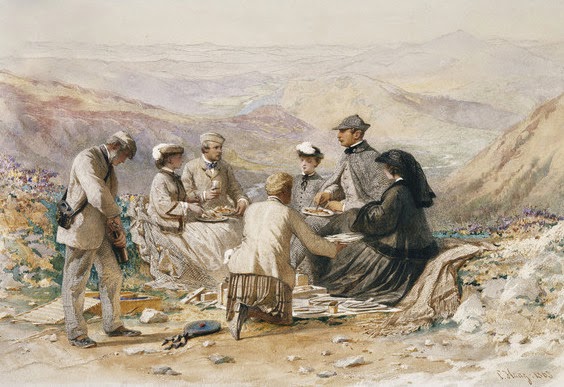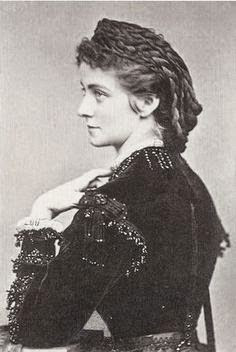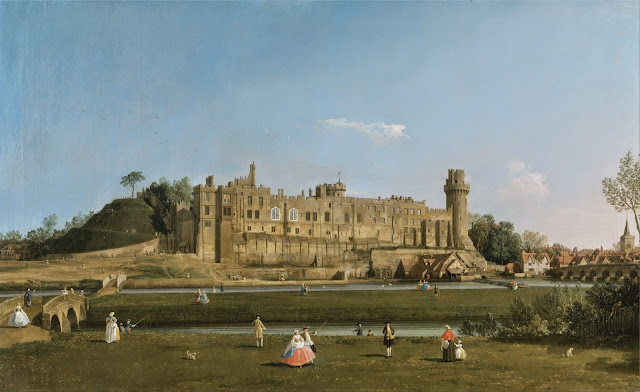“Madame can live in one room and the crinoline in the other one.”
Le Journal Illustré, 1867
Era il 1858 quando DOUGLAS & SHERWOOD misero a punto e brevettarono la hoop-skirt o cage-crinoline
dando con essa l'avvio ad una vera e propria epoca in quanto a storia della moda, epoca che si protrarrà fino al 1870 ca. quando le gonne meno ampie e sempre più affusolate non necessiteranno più di un siffatto sostegno; nasce essa infatti quale supporto per le gonne che in questo periodo raggiungono la loro massima ampiezza e scampanatura, nonché peso ed ingombro, per la diffusa presenza di balze ed ornamenti .... anche se fatte con tessuti importanti, a tenere tutto in bella forma ci pensava la nuova crinolina.
dando con essa l'avvio ad una vera e propria epoca in quanto a storia della moda, epoca che si protrarrà fino al 1870 ca. quando le gonne meno ampie e sempre più affusolate non necessiteranno più di un siffatto sostegno; nasce essa infatti quale supporto per le gonne che in questo periodo raggiungono la loro massima ampiezza e scampanatura, nonché peso ed ingombro, per la diffusa presenza di balze ed ornamenti .... anche se fatte con tessuti importanti, a tenere tutto in bella forma ci pensava la nuova crinolina.
Dico nuova perché già da anni esisteva la crinolina (1840) che come dice il termine stesso era fatta di crini di cavallo intrecciati e poi disposti a fare quasi da paniere, ma le gonne più ampie e più pesanti richiedevano un supporto più rigido, di legno o di metallo imbottito e rivestito di cotone sotto cui andava ovviamente indossata almeno una sottoveste. ( Era esattamente il 1830 quando in Francia fu messo a punto un materiale fatto di lino tessuto con crine di cavallo chiamato crinolina la cui definizione deriva dal francese'Crin'e'lin', ovvero rispettivamente crine e biancheria intima; era questa la versione originale della crinolina, termine che poi venne applicato in seguito anche alle versioni differenti e più evolute del capo.)
Tutt'altro che veloce ed agevole da indossare era sicuramente il vero orgoglio di chi la vestiva !
Le donne adoravano la cage-crinoline. Pensate che in Inghilterra, al culmine della sua popolarità, veniva prodotto tanto acciaio presso Sheffield quanto ne serviva per fabbricare mezzo milione di cerchi la settimana !
Entrare in una carrozza senza schiacciare i leggerissimi tessuti di tulle e pizzo richiedeva molto tempo, dei cavalli molto tranquilli, ed un marito di straordinaria pazienza!
Viaggiare, accovacciarsi, giocare con i bambini, o addirittura semplicemente tenere loro la mano e camminare con loro, erano problemi che richiedevano grande affetto e tanta buona volontà. "
Con l'introduzione della più alta e sofisticata moda vittoriana divenne sempre più semplice che le parti terminali di abiti talmente ingombranti fossero soggette ad infiammarsi: i lampadari a gas che nelle sale da ballo e nei salotti erano andati a sostituire quelli di cristallo ed i candelabri d'argento, le candele e le lampade a petrolio od olio erano spesso posti in luoghi pericolosi per gli scialli, per le maniche maniche ampie e le gonne voluminose, e le cronache del XIX secolo spesso ci parlano di terribili decessi per incendio - di come la duchessa de Maillé sia stata bruciata a morte dal caminetto della sua amica, di come l'arciduchessa Mathilde, scoperto il fumo, amasse fumare ma cercasse di tenere questo suo vizio celato e, nel tentativo di nascondere la sigaretta nella propria sottana, questa andò in fiamme e non si riuscì a salvarla, di come un'attrice francese sia stata incenerito sul palco ed infine di come la figlia della regina Vittoria, Victoria Princess Royal, sia riuscita quasi miracolosamente a sfuggire ad una morte analoga.
La rivista satirica inglese Punch, fondata nel 1851, traeva infiniti spunti proprio dalla cage-crinoline e dagli inconvenienti che ad essa erano legati dando vita a vignette umoristiche di sicuro effetto ...
... Raggiunta la sua massima ampiezza con i 180 cm di diametro, ovvero circa sei piedi, la crinolina, anche di conseguenza al disagio che procurava ( pensate anche al vento che spesso le capovolgeva impedendo alle Ladies di muoversi ), già nel 1894 aveva cominciato con l'appiattirsi gradualmente sul davanti e sui lati conservando il pieno volume solo sul retro - tale crinolina venne chiamata crinolette e fu presto soppiantata dal bustle, il supporto fatto di tessuti a sostegno dei drappeggi e dello strascico posteriore.
.... Vi confesso un segreto ... sapeste quanto, a suo tempo, mi fece sognare quest'immagine, ambientata nell'epoca in cui la crinolina aveva raggiunto la sua massima ampiezza ("Gone with the Wind"è ambientato alla vigilia dello scoppio della Guerra di Secessione che si protrasse tra il 1861 ed il 1865) quando, bambina, la vidi per la prima volta ... e probabilmente sarà accaduto anche a qualcuna di voi !
Vi saluto lettori ed amici miei cari, e vi lascio, magari, chissà, a sognare ancora un po' ...
... Vi abbraccio con affetto ed infinita gratitudine.
A presto ♥
Bibliografia:
Cynthia Overbeck Bix, Petticoats and Frock Coats: Revolution and Victorian-Age Fashions from the 1770s to the 1860s, Twenty First Century Books, 2011
Peter Chrisp, The Victorian Age: 6 (History of Costume and Fashion), Facts on File, 2005
“Madame can live in one room and the crinoline in the other one.”
- picture 1 - Le Journal Illustré, 1867
It was 1858 when DOUGLAS & SHERWOOD put up and patented the hoop-skirt or cage-crinoline
- picture 2
giving with it the start of a real age as to the history of fashion, a period which will run until 1870 ca. when skirts, less wide and increasingly tapering, won't need such a support anymore; in fact, it was born as a support for skirts that at that time reached their maximum amplitude and bell mouth, and weight and size, for the widespread presence of flounces and ornaments .... even if made with important and heavy fabrics, there was the new crinoline to keep everything in good shape !
- picture 3
I say 'the new crinoline' because for years there was already a crinoline (1840) which, as the term itself, was made of horse hair braided and willing to do almost a basket, but the gowns, larger and heavier more and more, required a more rigid support, better if made of wood or metal upholstered with cotton under which it was obviously worn at least one petticoat. (It was exactly 1830 when in France was developed a material made of linen fabric with horsehair called crinoline whose definition is derived from the French 'crin'and'lin', respectively horsehair and underwear; this was the crinoline original version, but the term was then applied also later to the different versions and most advanced of this accessory.)
- picture 4
- picture 5
- picture 6
- picture 7
- picture 8
Anything but quick and easy to wear it was definitely the true pride of those who wore it !
- picture 9
- picture 10
- picture 11
Women loved the cage-crinoline, just think that in England, at the height of its popularity, it was produced so much steel in Sheffield to manufacture half a million circles a week!
- picture 12
When the crinoline reached its maximum amplitude it became really very difficult, indeed virtually impossible, for more than two ladies to move with their skirts inside a small room."It was necessary," remarked a lady of the court of the Empress Eugenie, some years later,"and foresaw the movements each of the other very carefully, walking with very light step maintaining the poise while bringing such a volume. Sitting, then, was a real art if we think that it was necessary to prevent steel rims to put out of their place.
- picture 13
To get into a carriage without crushing the lightweight tulle and laces fabrics it was necessary such a long time, very quiet horses, and a husband with an extraordinary patience!
Travel, crouch, to play with the kids, or even simply hold their hand and walk with them, were problems that required great affection and good will for their solution. "
With the introduction of the highest and most sophisticated Victorian fashion it became more simple for clothes to were subject to ignite: gas chandeliers which inside dance halls and living rooms had replaced those in crystal snd silver, candles and oil lamps which were often placed in dangerous places for shawls, the wide sleeves and the voluminous skirts, well, the chronicles of the late XIXth century often speak of terrible fire deaths - of how the Duchess de Maille was burnt to death by the fireplace of her friend, of how Archduchess Mathilde, discovered smoking and loving it but trying to keep this hidden, in an attempt to hide the cigarette in her gown, this went flames and they failed to save her, of how a French actress was incinerated on stage and finally as the daughter of Queen Victoria, Princess Royal Victoria, has almost miraculously escaped a similar death.
The British satirical magazine Punch, founded in 1851, drew its inspiration from the infinite-cage crinolines and the inconveniences that were linked to it creating cartoons for sure effect ...
- picture 14
- picture 15
- picture 16
... After reaching its maximum amplitude with 180 cm in diameter, about six feet, the crinoline, also accordingly to the discomfort which it, alas, provided (you've also to think about the wind that often overturned them preventing the Ladies even to move), already in 1894 had begun with gradually flatten out the front and the sides retaining the full volume only on the back - this was called crinolette - and was soon supplanted by the bustle, the support made of fabrics and draperies placed on the back, in support of the train.
- picture 17
.... I confess you a secret ... you cannot imagine how, at its time, this image made me dream, I was a little girl when I watched it for the first time, set in the era when the crinoline had reached its maximum amplitude given that "Gone with the Wind" is set on the eve of the outbreak of the Civil War that went on between 1861 and 1865 .... and probably it happened to someone of you too !
- picture 18
I greet you,my dear readers and friends, and I leave you, maybe, I wonder, to dream a little more...
... I embrace you all with love and neverending gratitude.
See you soon ♥
Bibliography:
Cynthia Overbeck Bix, Petticoats and Frock Coats: Revolution and Victorian-Age Fashions from the 1770s to the 1860s, Twenty First Century Books, 2011
Peter Chrisp, The Victorian Age: 6 (History of Costume and Fashion), Facts on File, 2005

.jpg)
















































.jpg)














































































%2C%2BLe%2BReve.jpg)


%2B-%2BSoap%2BBubbles.jpg)




































































%2Britratto%2Bda%2BThomas%2BLawrence%2Bnel%2B1816.jpg)








































































































































